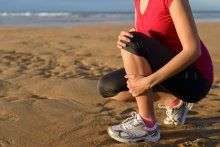
Shin splints are characterized by pain in the front part of the lower leg. It occurs on the inside edge of the large bone there — the tibia. This condition is common in runners, but can also occur in other physically active people.
Shin splints usually happen during or after a change in the intensity of physical activity, such as running more miles or more frequently.
Shin splints are not a standard medical diagnosis. The condition may also be called medial tibial stress syndrome (MTSS), anterior tibial pain or exercise-induced leg pain.
Causes of Shin Splints
Shin splints are very common among professional and recreational athletes, especially runners, military recruits and dancers.
Overuse of the leg muscles — without taking enough time to rest and heal — can lead to inflammation or swelling of the tendons, muscles or tissue covering the shin.
This causes pain along the front of the shin. Symptoms range from a dull, tight feeling to a sharp pain along the shin.
Several factors increase your chance of developing shin splints, such as:
- Running long distances or on hills or uneven surfaces
- Training incorrectly or too much
- Switching your routine
- Wearing the wrong shoes
- Not warming up properly
- Foot problems
In addition to excessive training, other conditions can also lead to pain in the shins, such as:
- Flat feet
- A very rigid arch of the foot
- Chronic anterior compartment syndrome (when the large muscle on the front of the lower leg becomes too large for the tissue that surrounds it)
- Stress fractures
Chiropractic Care for Shin Splints
Shin splints will often go away with basic therapy, which involves:
- Rest
- Ice
- Massage
- Rehabilitation exercises
- Stretching
- Kinesio taping
However, if the shin splits don't clear up quickly, your chiropractor will look for other problems that may be contributing to the pain. This includes examining your spine, hips, knees and feet for misalignments.
One problem with the foot that can lead to shin splints is over pronation — or “rolling in” of the foot. This condition causes overstretching in the shin muscles. If this is the case, your chiropractor may prescribe a foot orthotic for you. This will adjust how your foot strikes the ground.
Your chiropractor may also make adjustments in your foot joints, ankle, knee, SI joint or low back. This can relieve the pain from shin splints, or prevent them from happening again.
If you have shin splints, look for a chiropractor who specializes in treating sports injuries and conditions. This will help you return to your regular training program.
